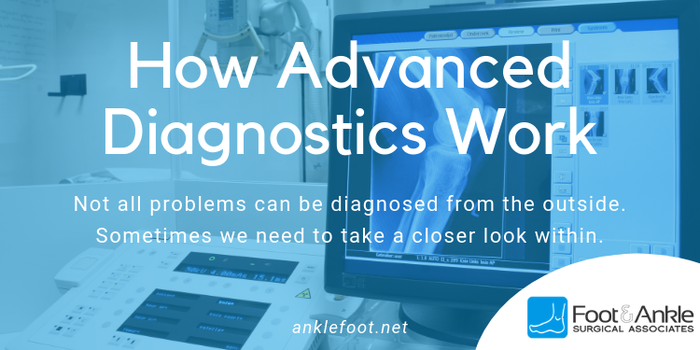Not all problems can be diagnosed from the outside. Sometimes we need to take a closer look within.
When podiatrists want imaging of the structures inside your foot or ankle, we want to have the best, clearest, and most useful images possible. When you actually take a look at one of these images, the reason why becomes clear.
The structures in these areas are among the most complicated in the body, containing more than a quarter of our total bones, not to mention all the muscles, tendons, and ligaments that make them work together! You want to ensure that you can pinpoint what you are seeing accurately.
There are times when an office might need to outsource a scan or X-ray to a lab because the equipment is not available in-office. We’re proud to say that, here at Foot & Ankle Surgical Associates, we have many advanced diagnostics right here, saving you time and getting to the source of your problems faster.
That, in turn, means a faster route to effective treatment!
Now, we won’t just wheel them out for a test drive, but here are a few of the technologies we have and how they work.
pedCAT 3D Imaging
A computed tomography (also known as CT or CAT) scan, creates a special, computer-generated 3D image out of X-rays taken at many different angles. It is a very important tool when you want to see how things relate to each other in space.
For a podiatrist, having access to such a 3D image can be extremely helpful when looking at the way bones are positioned when standing, or when looking at arthritic joints, among other cases.
The traditional image of a CAT scan is a huge device that you must lie down on and get sent through. This isn’t optimal for us because:
- Having to lie down means you are not bearing weight on your feet. That takes a lot of useful information off the table where many foot and ankle conditions are concerned.
- Frankly, we just don’t have the room.
Fortunately, pedCAT provides exactly the type of 3D imaging machine we need!
Designed specifically for use by foot and ankle doctors, pedCat looks more like a platform than a bed. A patient can comfortably stand (or sit, if needed) while the scan is performed, allowing for a 3D image in more natural or weight-bearing positions.
A typical scan takes less than 1 minute, whereas scheduling a time to receive a CT scan at a hospital would cause much further delay.
Digital X-Rays
In some cases, a standard X-ray is still best—just with the speed and convenience of modern technology.
Digital X-rays are 2D, unlike pedCAT. However, they may still be perfectly fine for certain situations, and even more useful when we are determining whether changes have been taking place in the bones themselves.
Having a more direct look at the bones can helps us detect fractures, naturally, but they also help us monitor whether a bone is healing from a fracture as it should. We can also have a better view of bone shape and density, which can help us detect the effects of a bone infection, arthritis, or other bone diseases.
What exactly do we mean by “digital” in this case? Whereas traditional X-rays were taken on film, the digital variety are sent straight to a computer. Results and histories are much easier to access, and you don’t have to worry about film getting lost!
Diagnostic Ultrasound
Ultrasound’s specialty lies with soft tissues, such as tendons and muscles. It can help us diagnose and pinpoint problems such as plantar fasciitis, tendonitis, neuromas, and other issues of strain, inflammation, and tears.
Soundwaves are the key to this form of imaging. A probe sends high-frequency waves through tissue, which are bounced back to the device. A computer takes the data it receives this way and composes it into a live image.
There is absolutely no pain during an ultrasound, nor is any radiation involved. (It’s also used to see babies in the womb, after all.)
Diagnostic ultrasound can also be an extremely useful tool after we know what’s wrong. We may use ultrasound to guide treatment directly to the source of an issue, or where it is needed most. This method can even be used to guide an injectable treatment in real time.
Imaging on Demand
Having tools in our office such as those we discussed above allow us to shorten the barriers of time and inconvenience that can stand between a patient’s discomfort and the treatment they need. You already have enough things in life you must run about to accomplish; we want to take care of everything foot- and ankle-related for you right here, whenever we can.
Whenever you or a loved one is experiencing a podiatric problem, Foot & Ankle Surgical Associates is here to help. Our offices are located in Centralia, Olympia, Tumwater, Tacoma, and Yelm, so you may never have to travel too far to reach us.
Call (360) 754-3318 to schedule an appointment. If you prefer, you may also fill out our online contact form and a member of our staff will reach out to you at the earliest opportunity.




